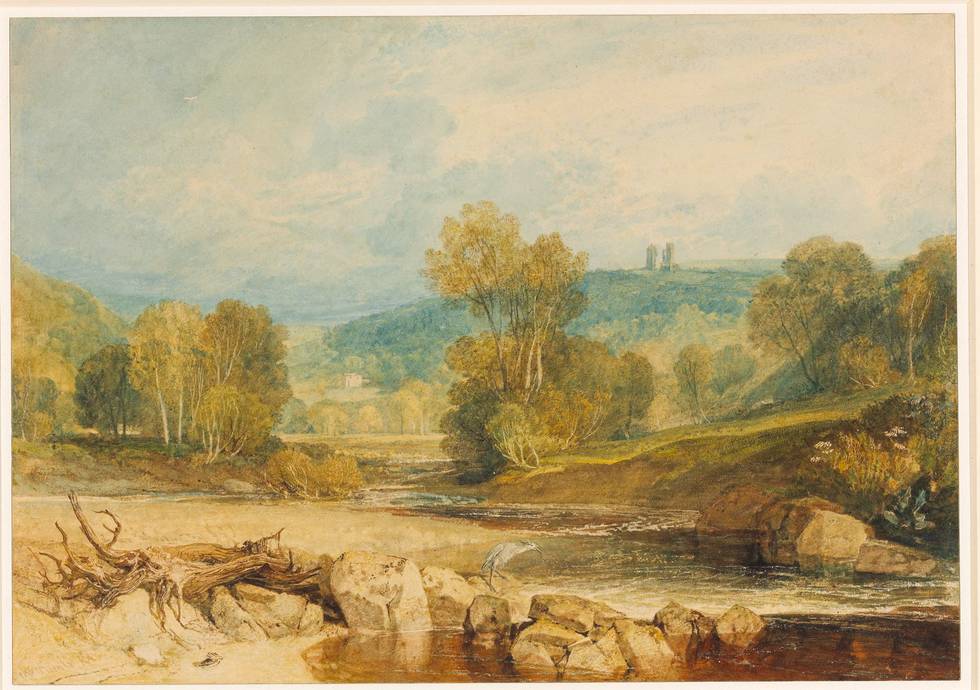The four landscape watercolours of Yorkshire by Turner were first owned by Sir William Pilkington, 8th Baronet, of Chevet Hall, near Wakefield, a landowner and amateur artist and related by marriage to Walter Fawkes. We do not know if Pilkington commissioned the works, but it seems more likely that Turner chose the subjects himself and offered the finished works for sale to his patron. Pilkington owned a total of 12 watercolours by Turner, including a view of the Washburn Valley, in the Yorkshire Dales, now at the British Museum.

The two hunting scenes, Woodcock Shooting at Otley Chevin and Grouse Shooting were published in 1852 by Joseph Hogarth (1801–1879) as chromolithographs by the Leighton Brothers. It is not known whether Hogarth acquired the Turner watercolours from William Pilkington, who died on 30 September 1850, or from Pilkington’s descendants. It is likely that work on the lithographs began while Turner was still alive (he died in December 1851) and that he was aware of them. They provide an invaluable document of how the watercolours would have looked in Turner’s day.
All four watercolours are next recorded in a major sale of Hogarth’s stock held 7–30 July 1854:
Lot 7537: ‘Scarborough, boys catching crabs, early morning, a most beautiful drawing, framed and glazed’
Lot 6269: ‘seat of the Earl of Ripon, in Yorkshire, framed and glazed’
Lot 6685: ‘Woodcock Shooting - Scene on the Chiver, framed and glazed’
Lot 6686: ‘Grouse Shooting- The Moor framed and glazed’ (‘These two drawings are the only sporting subjects the artist ever painted. They have been highly recommended by several eminent sportsmen for their accuracy and truthfulness.’)

They were acquired at the sale by Hogarth’s business partner, Elhanan Bicknell (1788-1861), who had made his fortune in the whaling industry. According to Bicknell’s nephew, Edgar Browne:
‘Besides the pictures on the walls, Mr Bicknell had stowed away others of equal importance. I shall never forget the thrill I experienced when he produced from a portfolio Turner’s four Yorkshire drawings [i.e. watercolours] which had never been exposed.’
However, they were in fact recorded in the Hogarth sale as framed and glazed; watercolours were often framed and mounted on the walls for exhibition, as they were at the large retrospective held by Walter Fawkes at his London residence in 1819.

At the sale by Christie’s of Elhanan Bicknell’s collection in 1863, all four were acquired by Richard Seymour Conway, 4th Marquess of Hertford (1800–1870) through his dealer, Wells, for 1,970 guineas (significantly more than the £600 Bicknell had paid for the four only nine years earlier). The lots were described as follows:
‘Scarborough Castle’, 1809: 520 guineas
‘Mowbray Lodge, Ripon’: 510 guineas
‘Grouse Shooting with a portrait of the artists and dogs by Stubbs’: 430 guineas
‘Woodcock Shooting with a Portrait of Sir Henry [William] Pilkington, 1813’: 510 guineas
We may wonder why the Anglo-French collector did not acquire more of the large range of Turner’s paintings available at the sale, choosing instead the four views of Yorkshire, a county he barely knew.
According to the 1890 inventory of Hertford House, the watercolours were kept either mounted or in portfolios. A photograph from this date, when Hertford’s likely son, Sir Richard Wallace (1818–1890), lived in the house, shows the Turners mounted in the Study in gilt frames. They were lent regularly to major exhibitions: the Art Treasures of the United Kingdom, Old Trafford, Manchester, 1857; Bethnal Green Museum, 1872–5, The Industrial Exhibition and Bazaar, Ulster Hall, Belfast, 23 May 1876; an exhibition of deceased British painters held at the Royal Academy in 1887.
While on display at the Bethnal Green Museum, they were admired by Henry James as ‘a full measure of his [Turner’s] genius’, who singled out Grouse Shooting and Hackfall for particular praise. He observed ‘what strikes us in works of the period to which these belong is their marvellous moderation. The painter’s touch is as assured as the beat of a musical phrase, and indeed to find a proper analogy for this rare exhibition of sustained and, as we may say, retained power, we must resort to a sister art and recall the impression of a great singer holding a withdrawn note and dealing it out with measured exactness.’
When the Wallace Collection opened to the public, they were displayed in corridors off the main galleries. They have been kept in storage since the 1980s, and were briefly on display in 2003 to complement the exhibition Constable to Delacroix. British Art and the French Romantics held at Tate. Our display marks the first time that the watercolours have been on display since that date.